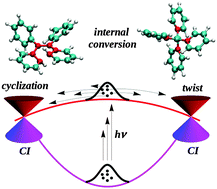How does tetraphenylethylene relax from its excited states?†
Abstract
Tetraphenylethylene is a prototypical example of a molecule displaying aggregation-induced emission. Despite many studies on the optical properties of TPE and its derivatives, the origin of the non-emissive behavior in the gas phase or in dilute solutions has yet to be unravelled. Here, we identify the ultrafast deactivation mechanisms responsible for the fluorescence quenching in isolated TPE.

- This article is part of the themed collection: Electron delocalization and aromaticity: 150 years of the Kekulé benzene structure

 Please wait while we load your content...
Please wait while we load your content...